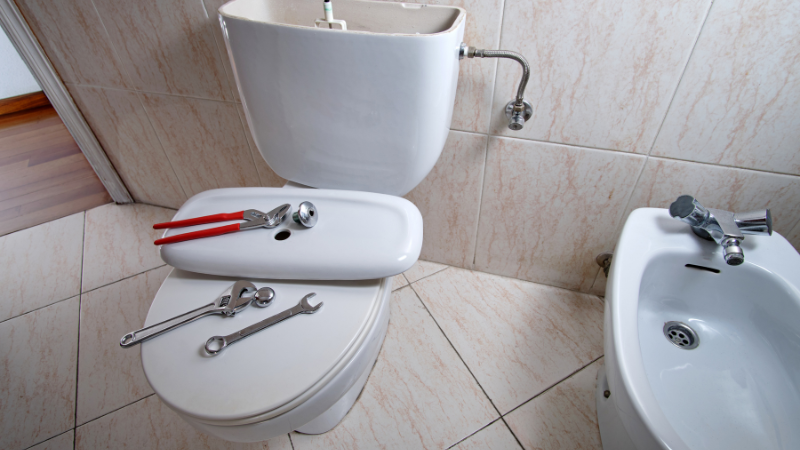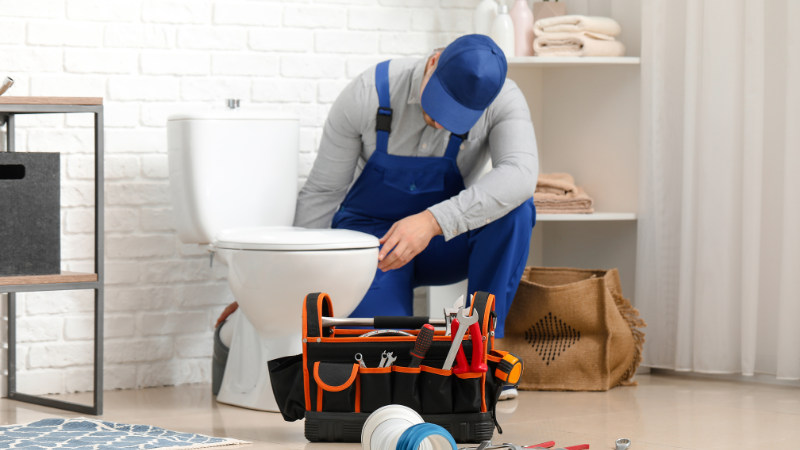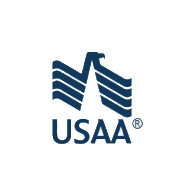Picture this: you’ve just had a long day at work, looking forward to unwinding in the comfort of your home. As you enter your humble abode, a foul odor greets you, and you notice something alarming – the carpet near the bathroom is soaked. Panic sets in as you realize that the toilet has overflowed, turning what was once a place of solace into a potential disaster zone.
A toilet overflow can result in a stinky mess—and an unsanitary one if the contaminated water spills onto the carpet. Toilet overflows can happen for a number of reasons. When they occur, however, it’s important for homeowners to take prompt action to limit the water damage.
Table of Contents
What causes a toilet to overflow?
Blockages in the plumbing can lead to a toilet overflow. Sometimes, the blockage is not immediately visible in the toilet bowl itself, but is concealed beyond it, in the pipes. The water level can rise even when the homeowner does not attempt to flush it down.
In most cases, however, the clog may be seen at the bottom of the toilet. Do not flush the toilet when encountering a clog. Doing so will cause the toilet bowl water to surpass the brim. Instead, use a plunger to plunge the toilet bowl.
A leak in the toilet can cause water to rise and overflow. Even if the toilet water does not reach the brim, consult a professional plumber. A leak of any size will lead to a costly water bill for the homeowner—and be a potential cause for a toilet overflow.
When a toilet overflow occurs, significant water damage can result. Not only are the floors and baseboards in the immediate vicinity affected, but the nearby carpets, too, especially if the water level increases. A carpet soaked in sewage water is not an easy mess to clean up.
1. Do not re-flush
A homeowner can take numerous steps when faced with a disastrous toilet overflow. Firstly, as mentioned, do not flush the toilet when it overflows. Although flushing may seem like a logical counter-maneuver, it will cause even more water to overflow. Plunge the overflowing toilet, instead.
2. Stop the flow of water
A plumber is not necessary for this step, as any homeowner can stop the waterflow. Simply remove the tank off the toilet and locate the flapper valve (a circular rubber valve). Reach inside (tank water is sanitary!) and close the flapper to prevent additional water from entering the toilet bowl.
Next, shut off the water valve located at the base of the toilet bowl, against the wall. Twist the valve clockwise, but do not force it. If the valve is rusted, apply a lubricant, like WD-40. If the waterflow persists, turn off the main water line from the basement.
3. Block access to bathroom
Now that the waterflow has stopped, cleanup should begin. Block access to the bathroom until the cleanup is completed and the area is fully disinfected. Contaminated water from the toilet overflow poses as a safety hazard to the home’s occupants and visitors.
4. Discard or clean the carpet
Cleaning a carpet saturated in contaminated toilet overflow should be done immediately. The longer the sewage water remains in the fibers, the more difficult it is to save the carpet. If the sewage water has been in contact with the carpet for 24 hours or more, discard the entire carpet.
Prior to handling the sewer water, wear protective gear. Put on long rubber gloves, a face mask, goggles and, most importantly, protective footwear. Goggles will come in useful in the event splashes occur during the cleanup task. Extremely long rubber gloves add extra skin protection.
Use a wet vacuum to extract the water. Old towels can also be laid down to absorb some of the mess. At some point after this step is completed, remember to clean the wet vac itself, as it will be contaminated with sewage water.
Liberally spray the carpet with a commercial carpet disinfectant. Give the fibers time to absorb the solution, then wash it off with clean water. If practical, remove the carpet and apply the disinfectant multiple times in an outside environment. Use a broom’s bristles to work the disinfectant into the fibers.
Dry the carpet thoroughly, as mold can develop within 24 to 48 hours after water exposure. Run a fan directed toward the fibers or run a dehumidifier. If the cleanup takes place in the bathroom, keep the door open to make use of the natural ventilation.
Run a bathroom steam cleaner over the water damaged carpet to remove lingering bacteria. The combination of pressure and heat from a powerful steam cleaner is effective in killing off harmful germs and bacteria. Allow the carpet to dry thoroughly by turning on the bathroom fan.
A carpet damaged by sewer water can potentially be saved—if the homeowner acts fast. But if the carpet has remained saturated with contaminated water for over 24 hours, it’s safer to throw it out to prevent the risk of developing a serious infection.

Handling a toilet overflow can be a DIY task. But when the contaminated mess is overwhelming, call the pros at ServiceMaster by Replacements. We offer quality water damage restoration services, including sewage water cleanup, to residential homes and commercial businesses.
Our technicians are IICRC certified, which means they are trained to handle dangerous sewage waste safely. Bacteria, pathogens, and viruses teem in sewer water, making it critical that only experienced professionals remove the water, disinfect the affected area, and return it to safe conditions.
The flood and water restoration services by ServiceMaster by Replacements are comprehensive. We offer content cleaning at our state-of-the-art facility, where specialists restore damaged goods. Our equipment is among the most advanced in the industry. We also assist you with insurance claims.
Water damage can occur for numerous reasons, from flooding to burst pipes and appliance malfunctions. No matter the cause, act swiftly to prevent the spread of water damage. Our technicians are available 24 hours a day, 365 days a year, to respond to emergencies.
ServiceMaster by Replacements is trusted by home and business owners in New Jersey. We’ve been their go-to resource for over 30 years. When you walk into a water damage scenario, consult our experts.
Our efficient flood cleanup services will restore your property quickly, call us at (732) 842-6917.







